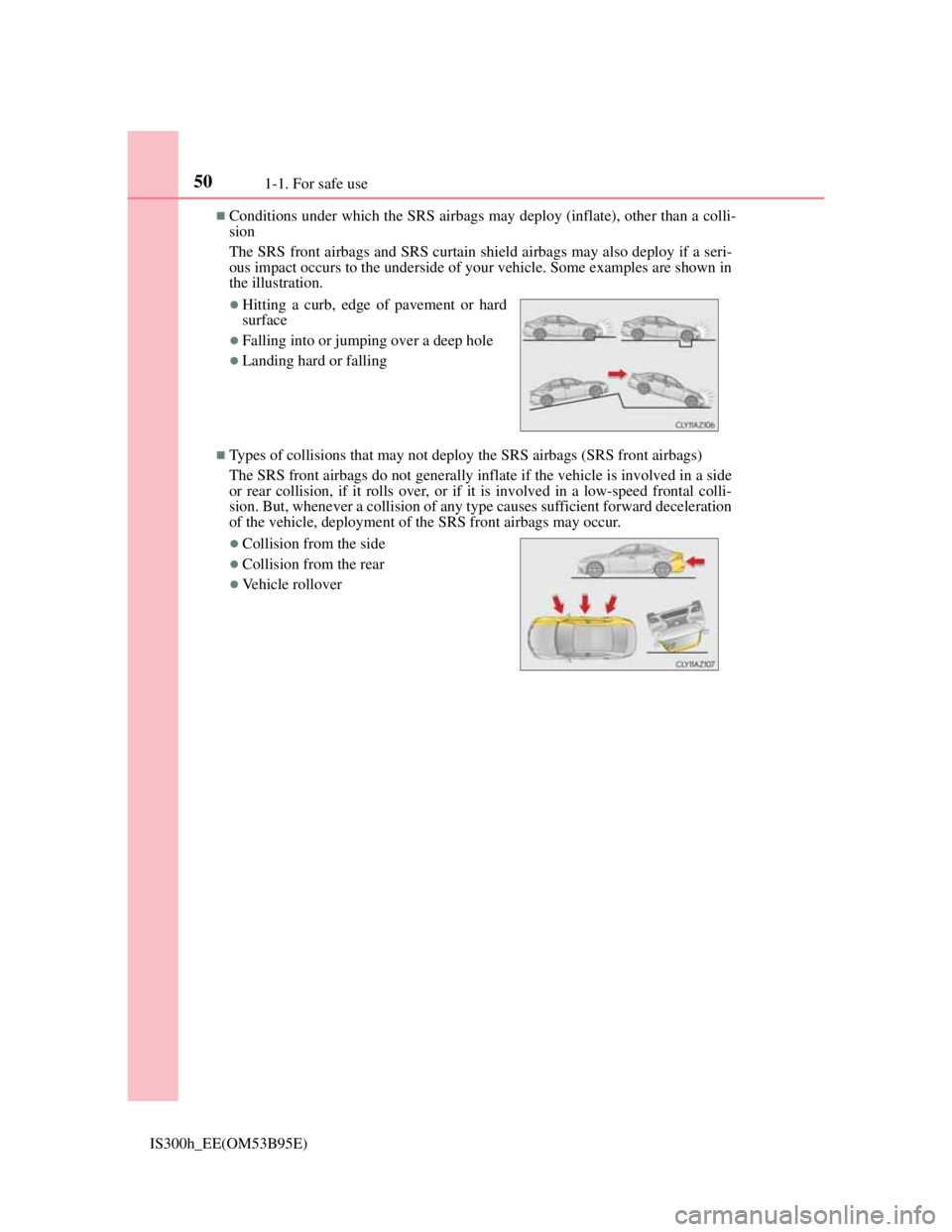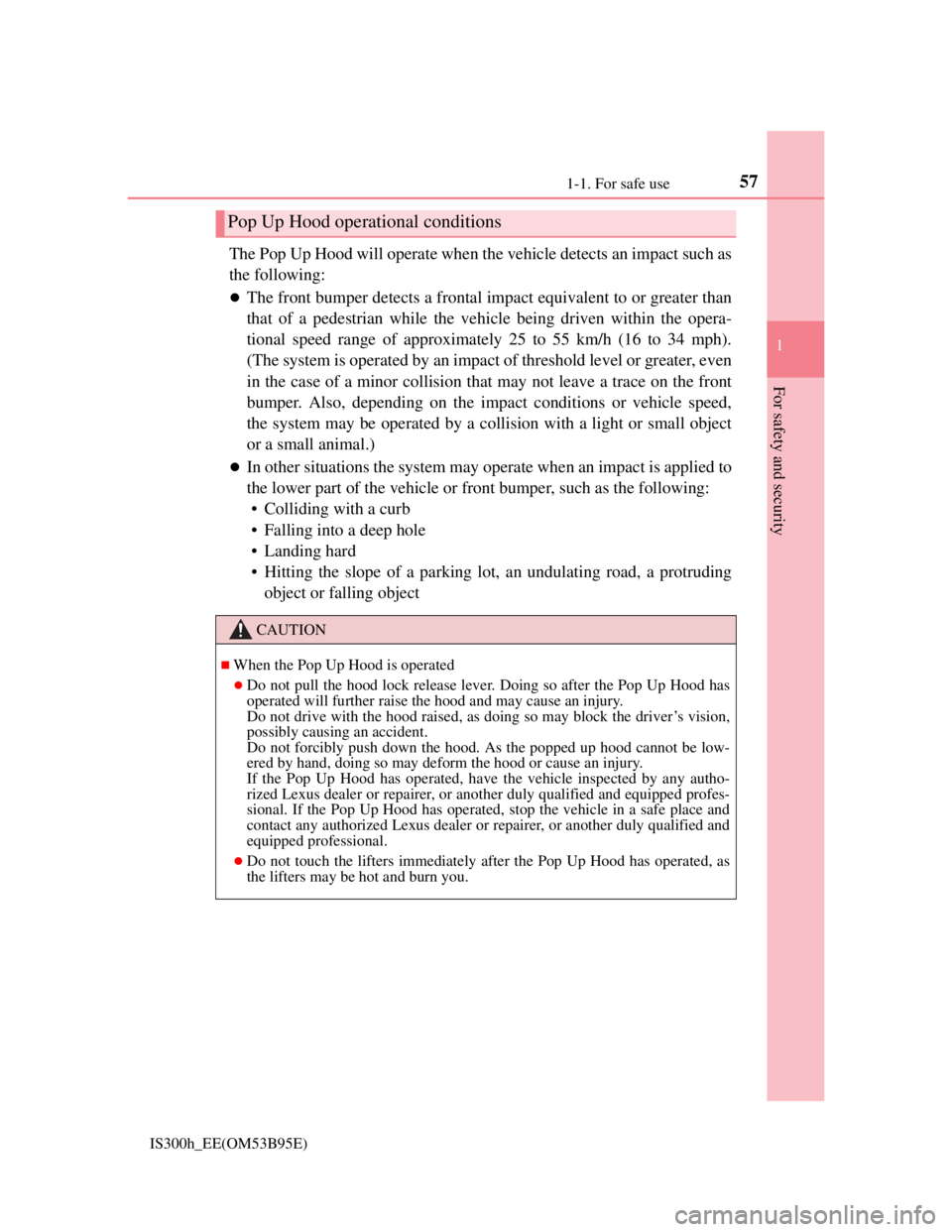air condition Lexus IS300h 2013 Owner's Manual
[x] Cancel search | Manufacturer: LEXUS, Model Year: 2013, Model line: IS300h, Model: Lexus IS300h 2013Pages: 628, PDF Size: 20.23 MB
Page 5 of 628

5
1
9 8
7
6 4 3
2
IS300h_EE(OM53B95E)
5
5-8. Bluetooth® Audio
Listening to Bluetooth
®
Audio .............................. 365
5-9. Bluetooth
® Phone
Using a Bluetooth
®
Phone .............................. 367
Making a call..................... 369
Receiving a call ................. 372
Speaking on the phone ...... 373
Using a Bluetooth
®
phone messages............... 375
Using the steering wheel
switches ........................... 378
Bluetooth
® phone
settings ............................ 379
5-10. Phonebook
Contact settings ................. 381
Messaging setting.............. 384
5-11. Bluetooth
®
Bluetooth®....................... 385
5-12. Other function
“Information” screen ......... 390
MirrorLink..................... 391
USB photo ......................... 393
Speech command system .. 3956-1. Using the air conditioning
system
Automatic air conditioning
system ............................. 398
Heated steering wheel/
seat heaters/
seat ventilators ................ 409
6-2. Using the interior lights
Interior lights list ............... 411
• Interior lights ................ 412
• Personal lights ............... 412
6-3. Using the storage features
List of storage features ...... 413
• Glove box...................... 414
• Console box .................. 414
• Cup holders/
Bottle holders ................ 415
Trunk features ................... 417
6-4. Using the other interior
features
Other interior features ....... 420
• Sun visors...................... 420
• Vanity mirrors ............... 420
• Clock ............................. 420
• Power outlet .................. 421
• Armrest ......................... 422
• Rear sunshade ............... 422
• Assist grips.................... 424
• Coat hooks .................... 424
6Interior features
Page 6 of 628

TABLE OF CONTENTS6
IS300h_EE(OM53B95E)
7-1. Maintenance and care
Cleaning and protecting
the vehicle exterior.......... 426
Cleaning and protecting
the vehicle interior .......... 430
7-2. Maintenance
Maintenance
requirements.................... 433
7-3. Do-it-yourself maintenance
Do-it-yourself service
precautions ...................... 435
Hood .................................. 437
Positioning a floor jack ..... 438
Engine compartment ......... 439
12-volt battery ................... 447
Tires................................... 450
Replacing the tire .............. 460
Tire inflation pressure ....... 466
Wheels............................... 468
Air conditioning filter ....... 470
Electronic key battery ....... 472
Checking and replacing
fuses ................................ 475
Light bulbs ........................ 4798-1. Essential information
Emergency flashers ........... 498
If your vehicle has to be
stopped in an
emergency ....................... 499
8-2. Steps to take in an
emergency
If your vehicle needs to
be towed .......................... 500
If you think something
is wrong........................... 506
If a warning light turns
on or a warning buzzer
sounds ............................. 507
If a warning message is
displayed ......................... 513
If you have a flat tire
(vehicles without
run-flat tires) ................... 530
If you have a flat tire
(vehicles with
run-flat tires) ................... 544
If the hybrid system will
not start............................ 545
If the shift lever cannot
be shifted from P ............. 547
7Maintenance and care8When trouble arises
Page 17 of 628

17Pictorial index
IS300h_EE(OM53B95E)
Multi-information display . . . . . . . . . . . . . . . . . . . . . . . . . . . . . P. 115
Display. . . . . . . . . . . . . . . . . . . . . . . . . . . . . . . . . . . . . . . . . . . . . . P. 115
Energy monitor . . . . . . . . . . . . . . . . . . . . . . . . . . . . . . . . . . . . . . . P. 121
When the warning messages are displayed . . . . . . . . . . . . . . . . . . P. 513
Parking brake . . . . . . . . . . . . . . . . . . . . . . . . . . . . . . . . . . . . . . P. 224
Applying/releasing . . . . . . . . . . . . . . . . . . . . . . . . . . . . . . . . . . . . P. 224
Precautions against winter season . . . . . . . . . . . . . . . . . . . . . . . . . P. 312
Warning buzzer/message . . . . . . . . . . . . . . . . . . . . . . . . . . . . . . . . P. 513
Turn signal lever . . . . . . . . . . . . . . . . . . . . . . . . . . . . . . . . . . . . P. 222
Headlight switch . . . . . . . . . . . . . . . . . . . . . . . . . . . . . . . . . . . . . . P. 226
Headlights/front position lights/tail lights/daytime running lights P. 226
Front fog lights
*1/rear fog light . . . . . . . . . . . . . . . . . . . . . . . . . . P. 233
Windshield wiper and washer switch . . . . . . . . . . . . . . . . . . . . P. 235
Usage . . . . . . . . . . . . . . . . . . . . . . . . . . . . . . . . . . . . . . . . . . . . . . . P. 235
Adding washer fluid . . . . . . . . . . . . . . . . . . . . . . . . . . . . . . . . . . . P. 446
Warning messages . . . . . . . . . . . . . . . . . . . . . . . . . . . . . . . . . . . . . P. 521
Emergency flasher switch . . . . . . . . . . . . . . . . . . . . . . . . . . . . . P. 498
Trunk opener . . . . . . . . . . . . . . . . . . . . . . . . . . . . . . . . . . . . . . . P. 143
Hood lock release lever. . . . . . . . . . . . . . . . . . . . . . . . . . . . . . . P. 437
Tilt and telescopic steering control switch
*1. . . . . . . . . . . . . . P. 176
Adjustment . . . . . . . . . . . . . . . . . . . . . . . . . . . . . . . . . . . . . . . . . . P. 176
Driving position memory*1 . . . . . . . . . . . . . . . . . . . . . . . . . . . . . P. 168
Tilt and telescopic steering lock release lever*1 . . . . . . . . . . . P. 176
Adjustment . . . . . . . . . . . . . . . . . . . . . . . . . . . . . . . . . . . . . . . . . . P. 176
Air conditioning system . . . . . . . . . . . . . . . . . . . . . . . . . . . . . . P. 398
Usage . . . . . . . . . . . . . . . . . . . . . . . . . . . . . . . . . . . . . . . . . . . . . . . P. 398
Rear window defogger . . . . . . . . . . . . . . . . . . . . . . . . . . . . . . . . . P. 404
Audio system*1, 2. . . . . . . . . . . . . . . . . . . . . . . . . . . . . . . . . . . P. 316
Audio system . . . . . . . . . . . . . . . . . . . . . . . . . . . . . . . . . . . . . . . . . P. 316
Hands-free system . . . . . . . . . . . . . . . . . . . . . . . . . . . . . . . . . . . . . P. 367
Trunk opener main switch . . . . . . . . . . . . . . . . . . . . . . . . . . . . P. 145
*1: If equipped
*2: For vehicles with a navigation system, refer to “Navigation System Owner's
Manual”.
4
5
6
7
8
9
10
11
12
13
14
15
Page 25 of 628

25Pictorial index
IS300h_EE(OM53B95E)
Multi-information display . . . . . . . . . . . . . . . . . . . . . . . . . . . . . P. 115
Display. . . . . . . . . . . . . . . . . . . . . . . . . . . . . . . . . . . . . . . . . . . . . . P. 115
Energy monitor . . . . . . . . . . . . . . . . . . . . . . . . . . . . . . . . . . . . . . . P. 121
When the warning messages are displayed . . . . . . . . . . . . . . . . . . P. 513
Parking brake . . . . . . . . . . . . . . . . . . . . . . . . . . . . . . . . . . . . . . P. 224
Applying/releasing . . . . . . . . . . . . . . . . . . . . . . . . . . . . . . . . . . . . P. 224
Precautions against winter season . . . . . . . . . . . . . . . . . . . . . . . . . P. 312
Warning buzzer/message . . . . . . . . . . . . . . . . . . . . . . . . . . . . . . . . P. 513
Turn signal lever . . . . . . . . . . . . . . . . . . . . . . . . . . . . . . . . . . . . P. 222
Headlight switch . . . . . . . . . . . . . . . . . . . . . . . . . . . . . . . . . . . . . . P. 226
Headlights/front position lights/tail lights/daytime running lights P. 226
Front fog lights
*1/rear fog light . . . . . . . . . . . . . . . . . . . . . . . . . . P. 233
Windshield wiper and washer switch . . . . . . . . . . . . . . . . . . . . P. 235
Usage . . . . . . . . . . . . . . . . . . . . . . . . . . . . . . . . . . . . . . . . . . . . . . . P. 235
Adding washer fluid . . . . . . . . . . . . . . . . . . . . . . . . . . . . . . . . . . . P. 446
Warning messages . . . . . . . . . . . . . . . . . . . . . . . . . . . . . . . . . . . . . P. 521
Emergency flasher switch . . . . . . . . . . . . . . . . . . . . . . . . . . . . . P. 498
Trunk opener . . . . . . . . . . . . . . . . . . . . . . . . . . . . . . . . . . . . . . . P. 143
Hood lock release lever. . . . . . . . . . . . . . . . . . . . . . . . . . . . . . . P. 437
Tilt and telescopic steering control switch
*1. . . . . . . . . . . . . . P. 176
Adjustment . . . . . . . . . . . . . . . . . . . . . . . . . . . . . . . . . . . . . . . . . . P. 176
Driving position memory*1 . . . . . . . . . . . . . . . . . . . . . . . . . . . . . P. 168
Tilt and telescopic steering lock release lever*1 . . . . . . . . . . . P. 176
Adjustment . . . . . . . . . . . . . . . . . . . . . . . . . . . . . . . . . . . . . . . . . . P. 176
Air conditioning system . . . . . . . . . . . . . . . . . . . . . . . . . . . . . . P. 398
Usage . . . . . . . . . . . . . . . . . . . . . . . . . . . . . . . . . . . . . . . . . . . . . . . P. 398
Rear window defogger . . . . . . . . . . . . . . . . . . . . . . . . . . . . . . . . . P. 404
Audio system*1, 2. . . . . . . . . . . . . . . . . . . . . . . . . . . . . . . . . . . P. 316
Audio system . . . . . . . . . . . . . . . . . . . . . . . . . . . . . . . . . . . . . . . . . P. 316
Hands-free system . . . . . . . . . . . . . . . . . . . . . . . . . . . . . . . . . . . . . P. 367
Trunk opener main switch . . . . . . . . . . . . . . . . . . . . . . . . . . . . P. 145
*1: If equipped
*2: For vehicles with a navigation system, refer to “Navigation System Owner's
Manual”.
4
5
6
7
8
9
10
11
12
13
14
15
Page 49 of 628

491-1. For safe use
1
For safety and security
IS300h_EE(OM53B95E)
If the SRS airbags deploy (inflate)
Bruising and slight abrasions may result from contact with a deploying (inflat-
ing) SRS airbag.
A loud noise and white powder will be emitted.
Parts of the airbag module (steering wheel hub, airbag cover and inflator) as
well as the front seats, parts of the front and rear pillars, and roof side rails, may
be hot for several minutes. The airbag itself may also be hot.
The windshield may crack.
SRS airbag deployment conditions (SRS front airbags)
The SRS front airbags will deploy in the event of an impact that exceeds the set
threshold level (the level of force corresponding to an approximately 20 - 30
km/h [12 - 18 mph] frontal collision with a fixed wall that does not move or
deform).
However, this threshold velocity will be considerably higher in the following
situations:
• If the vehicle strikes an object, such as a parked vehicle or sign pole, which
can move or deform on impact
• If the vehicle is involved in an underride collision, such as a collision in
which the front of the vehicle “underrides”, or goes under, the bed of a truck
Depending on the type of collision, it is possible that only the seat belt preten-
sioners will activate.
SRS airbag deployment conditions (SRS side and curtain shield airbags)
The SRS side and curtain shield airbags will deploy in the event of an impact
that exceeds the set threshold level (the level of force corresponding to the
impact force produced by an approximately 1500 kg [3300 lb.] vehicle collid-
ing with the vehicle cabin from a direction perpendicular to the vehicle orienta-
tion at an approximate speed of 20 - 30 km/h [12 - 18 mph]).
The SRS curtain shield airbags may also deploy in the event of a severe frontal
collision.
Page 50 of 628

501-1. For safe use
IS300h_EE(OM53B95E)
Conditions under which the SRS airbags may deploy (inflate), other than a colli-
sion
The SRS front airbags and SRS curtain shield airbags may also deploy if a seri-
ous impact occurs to the underside of your vehicle. Some examples are shown in
the illustration.
Types of collisions that may not deploy the SRS airbags (SRS front airbags)
The SRS front airbags do not generally inflate if the vehicle is involved in a side
or rear collision, if it rolls over, or if it is involved in a low-speed frontal colli-
sion. But, whenever a collision of any type causes sufficient forward deceleration
of the vehicle, deployment of the SRS front airbags may occur.
Hitting a curb, edge of pavement or hard
surface
Falling into or jumping over a deep hole
Landing hard or falling
Collision from the side
Collision from the rear
Vehicle rollover
Page 57 of 628

571-1. For safe use
1
For safety and security
IS300h_EE(OM53B95E)
The Pop Up Hood will operate when the vehicle detects an impact such as
the following:
The front bumper detects a frontal impact equivalent to or greater than
that of a pedestrian while the vehicle being driven within the opera-
tional speed range of approximately 25 to 55 km/h (16 to 34 mph).
(The system is operated by an impact of threshold level or greater, even
in the case of a minor collision that may not leave a trace on the front
bumper. Also, depending on the impact conditions or vehicle speed,
the system may be operated by a collision with a light or small object
or a small animal.)
In other situations the system may operate when an impact is applied to
the lower part of the vehicle or front bumper, such as the following:
• Colliding with a curb
• Falling into a deep hole
• Landing hard
• Hitting the slope of a parking lot, an undulating road, a protruding
object or falling object
Pop Up Hood operational conditions
CAUTION
When the Pop Up Hood is operated
Do not pull the hood lock release lever. Doing so after the Pop Up Hood has
operated will further raise the hood and may cause an injury.
Do not drive with the hood raised, as doing so may block the driver’s vision,
possibly causing an accident.
Do not forcibly push down the hood. As the popped up hood cannot be low-
ered by hand, doing so may deform the hood or cause an injury.
If the Pop Up Hood has operated, have the vehicle inspected by any autho-
rized Lexus dealer or repairer, or another duly qualified and equipped profes-
sional. If the Pop Up Hood has operated, stop the vehicle in a safe place and
contact any authorized Lexus dealer or repairer, or another duly qualified and
equipped professional.
Do not touch the lifters immediately after the Pop Up Hood has operated, as
the lifters may be hot and burn you.
Page 58 of 628

581-1. For safe use
IS300h_EE(OM53B95E)
Pop Up Hood precautions
Before scrapping your vehicle, make sure to contact any authorized Lexus
dealer or repairer, or another duly qualified and equipped professional.
The Pop Up Hood system cannot be reused once it has operated. Have it
replaced by any authorized Lexus dealer or repairer, or another duly qualified
and equipped professional.
Conditions under which the Pop Up Hood may not operate properly
The Pop Up Hood may not operate properly under the following conditions:
If a pedestrian collides with the right or left corner of the front bumper or the
side of the vehicle. As such impacts may be difficult to detect, the system may
not operate.
If the vehicle speed is not detected correctly, such as if the vehicle is sliding
sideways, the system may not operate properly.
Conditions under which the Pop Up Hood may not operate
The Pop Up Hood may not operate in the following situations:
Colliding with a lying pedestrian
A frontal impact applied to the front bumper while driving at speeds outside of
the operational speed range
A side impact or rear impact
A vehicle rollover (In some accident situations, the Pop Up Hood may operate.)
Page 82 of 628

811-2. Hybrid system
1
For safety and security
IS300h_EE(OM53B95E)
Regenerative braking
In the following situations, kinetic energy is converted to electric energy and
deceleration force can be obtained in conjunction with the recharging of the
hybrid battery (traction battery).
The accelerator pedal is released while driving with the shift lever in D or S.
The brake pedal is depressed while driving with the shift lever in D or S.
EV indicator
Conditions in which the gasoline engine may not stop
The gasoline engine starts and stops automatically. However, it may not stop
automatically in the following conditions:
During gasoline engine warm-up
During hybrid battery (traction battery) charging
When the temperature of the hybrid battery (traction battery) is high or low
When the heater is switched on
Charging the hybrid battery (traction battery)
As the gasoline engine charges the hybrid battery (traction battery), the battery
does not need to be charged from an outside source. However, if the vehicle is
left parked for a long time the hybrid battery will slowly discharge. For this rea-
son, be sure to drive the vehicle at least once every few months for at least 30
minutes or 16 km (10 miles). If the hybrid battery becomes fully discharged and
you are unable to jump-start the vehicle with a 12-volt battery, contact any
authorized Lexus dealer or repairer, or another duly qualified and equipped pro-
fessional.
If the shift lever is in N, the hybrid battery (traction battery) will not be charged.
Always shift the shift lever to P when the vehicle is stopped. When driving in
heavy traffic, operate the vehicle with the shift lever in D or S to avoid dis-
charging the battery.
Charging the 12-volt battery
P. 552 The EV indicator comes on when the vehi-
cle is driven using only the electric motor
(traction motor) or the gasoline engine is
stopped.
Page 84 of 628

831-2. Hybrid system
1
For safety and security
IS300h_EE(OM53B95E)
Hybrid system precautions
Take care when handling the hybrid system, as it is a high voltage system
(about 650 V at maximum) as well as contains parts that become
extremely hot when the hybrid system is operating. Obey the caution
labels attached to the vehicle.
Caution label
Power control unit
Electric motor (traction motor)
Hybrid battery (traction battery)Service plug
High voltage cables (orange)
Air conditioning compressor1
2
3
4
5
6
7